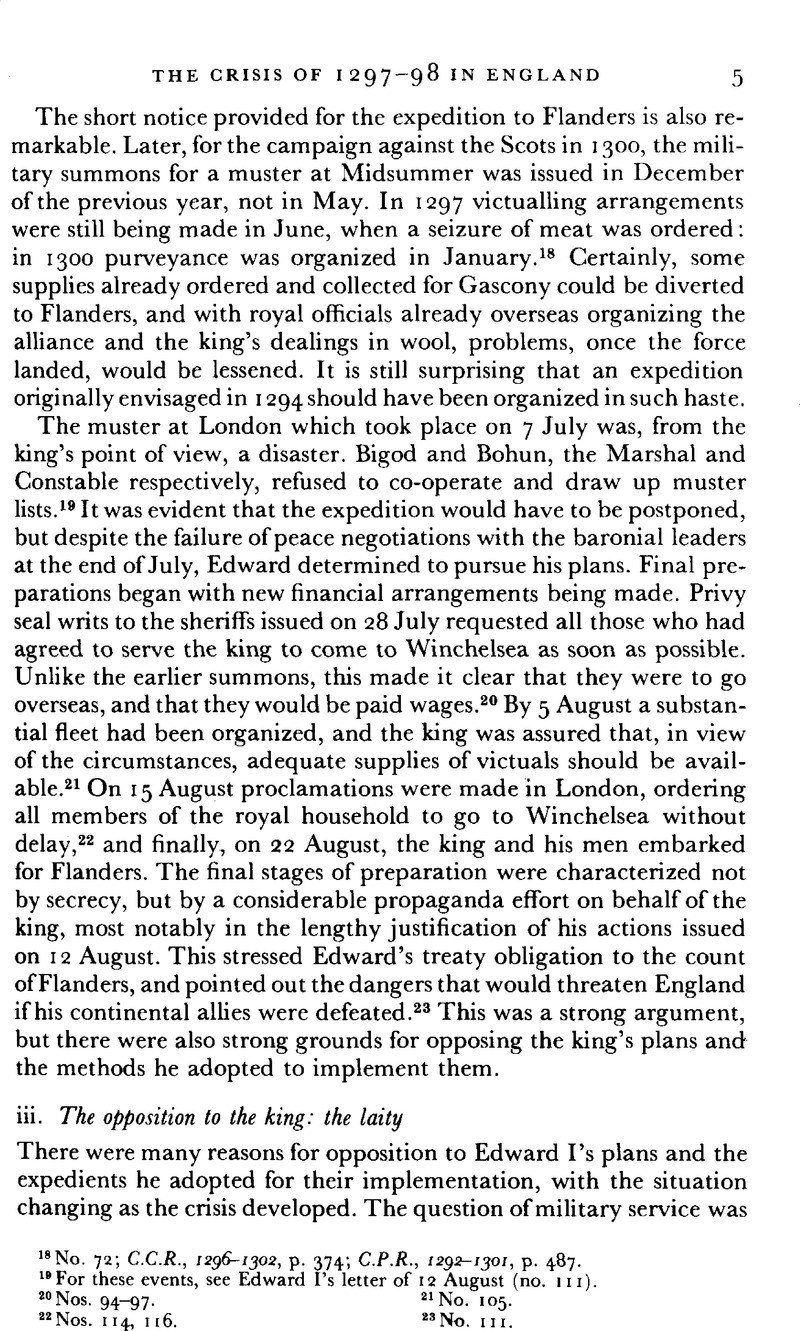No CrossRef data available.
Published online by Cambridge University Press: 21 December 2009

24 Prestwich, M. C., War, Politics and Finance under Edward I (London, 1972), pp. 84–86Google Scholar. The fear of disinheritance is also expressed in the additional clause of the Worcester version of the Remonstrances (no. 98).
25 For an argument which places the Remonstrances in the context of such theories, see Harriss, , King, Parliament and Public Finance, pp. 61–2.Google Scholar
26 No. 132.
27 Denton, J. H., ‘The Crisis of 1297 from the Evesham Chronicle’, E.H.R., xciii (1978), 576.CrossRefGoogle Scholar
28 Lewis, N. B., ‘The English Forces in Flanders’, Studies in Medieval History presented to F. M. Powicke, ed. Hunt, R. W., Pantin, W. A. and Southern, R. W. (Oxford, 1948), p. 311, n. 1.Google Scholar
29 C.P.R., 1292–1301, pp. 292, 300, 302, 303, 305, 307, 312, 314Google Scholar. A different type of excuse for not going on the campaign was produced by Theobald de Verdun; he was ill, and his eldest son had recently died. Edward, however, ordered him to send his younger son (Parl. Writs, i, 295).Google Scholar
30 No. 106.
31 Wilkinson, , Constitutional History, i, 198–9.Google Scholar
32 No. 94.
33 B.L., Add. MS. 7965, fos. 73–4. See also Powicke, M. R., Military Obligation in Medieval England (Oxford, 1962), pp. 111–12Google Scholar. He concludes that with the summons of twenty librate men, ‘over a hundred cavalry may have been added in this way’. This estimate includes those serving in the retinues of magnates, whereas the sixty-three listed in the wardrobe book were not part of any retinue.
34 The Hagnaby chronicle, B.L., Cotton MS. Vesp. B. xi, fo. 56.
35 Lancashire Lay Subsidies, ed. Vincent, J. A. C. (Lancs, and Cheshire Record Society, xxvii, 1893), pp. 191–5Google Scholar; infra, no. 47.
36 No. 74.
37 A Lincolnshire Assize Roll for 1298, pp. xlii–lii.Google Scholar
38 Nos. 95, 93; Flores Historiarum, ed. Luard, H. R., iii (Rolls Series, 1890), 296.Google Scholar
39 No. 96; Beddoe, , ‘Some Financial and Political Aspects of the Constitutional Crisis of 1297’, pp. 22–3.Google Scholar
40 C.P.R., 1292–1301, pp. 297–8.Google Scholar
41 No. 126.
42 Foedera, I, ii, 877Google Scholar; Parl. Writs, i, 58.Google Scholar
43 No. 136.
44 E 159/68, m. 82. For a discussion of the maltolt, see Lloyd, T. H., The English Wool Trade in the Middle Ages (Cambridge, 1977), pp. 76–96.CrossRefGoogle Scholar
45 Nos. 71, 180.
46 No. 45; Fryde, , ‘Financial Resources of Edward I in the Netherlands’, 1182.Google Scholar
47 Nos. 31, 199.
48 No. 124. Compare the incident of the restoration of thirty sacks of wool to the earl of Lincoln (no. 65).
49 Lloyd, , English Wool Trade, p. 77Google Scholar; infra, nos. 173, 174.
50 C.C.R., 1296–1302, p. 111Google Scholar; infra, no. 208.
51 Lloyd, , English Wool Trade, pp. 87–8Google Scholar; Sayles, G. O., ‘The Seizure of Wool at Easter 1297’, E.H.R., lxvii (1952), 543–7.CrossRefGoogle Scholar
52 No. 37.
53 Lloyd, , English Wool Trade, p. 87Google Scholar; E 101/457/3.
54 Nos. 63, 64.
55 Nos. 56, 79, 201, 207.
56 Lloyd, , English Wool Trade, pp. 90–3.Google Scholar
57 E 122/156/19. For a late repayment, see C.P.R., 1313–18, p. 252.Google Scholar
58 Nos. 97, 120, 125.
59 Nos. 111, 99, 168.
60 C.P.R., 1292–1301, pp. 299–300, 310–11, 321–3, 332, 335Google Scholar; Lloyd, , English Wool Trade, p. 91Google Scholar. For further calculations of the yield of the prises, see de Sturler, J., Les relations politiques et les échanges commerciaux entre le duché de Brabant et l'Angleterre au moyen âge (Paris, 1936), pp. 193–4Google Scholar; Fryde, , ‘Financial Resources of Edward I in the Netherlands’, 1183.Google Scholar
61 E 159/70, mm. 119–20. For a discussion of the burden of purveyance, see Maddicott, J. R., The English Peasantry and the Demands of the Crown, 1294–1341 (Past and Present Supplement, no. 1, 1975), pp. 15–34.Google Scholar
62 Nos. 50, 72.
63 B.L., Add. MS. 7965, fos. 44–50, 89, 93, 96–7. E 101/6/18 contains indentures with specific details of many shipments; see also Rôles Gascons, iii, clv–viGoogle Scholar, notes. The sheriffs' accounts are summarized in E 159/71, mm. 7–8d, 10, 13, 34, 50, 84d seq., and in C 62/74.
64 E 13/21, m. 64d.
65 Denton, , ‘The Crisis of 1297 from the Evesham Chronicle’, 575–7.Google Scholar
66 No. 172.
67 Nos. 89, 91. In their letter describing the events of 22 August at the exchequer, the treasurer and barons described Bigod as earl marshal, but only accorded Bohun his territorial title of Hereford (no. 126).
68 No. 10.
69 No. 90.
70 McFarlane, K. B., The Nobility of Later Medieval England (Oxford, 1973), p. 254.Google Scholar
71 Book of Prests of the King's Wardrobe for 1294–5, ed. Fryde, E. B. (Oxford, 1962), p. xlviii, n. 5.Google Scholar
72 Denton, , ‘The Crisis of 1297 from the Evesham Chronicle’, 576.Google Scholar
73 Willard, J. F., Parliamentary Taxation on Personal Property, 1290 to 1334 (Cambridge, Mass., 1934), p. 32Google Scholar; Book of Prests, p. xlviii, n. 5.Google Scholar
74 No. 37.
75 C.C.R., 1296–1302, p. 107.Google Scholar
76 Nos. 89, 108. For a further discussion of the significance of the marcher lordships in 1297, see Davies, R. R., Lordship and Society in the March of Wales, 1282–1400 (Oxford, 1978), pp. 267–9.Google Scholar